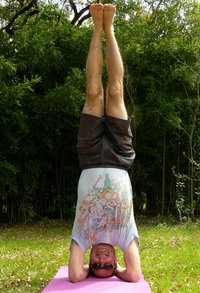It’s no secret that humans develop aches and pains in the normal course of spending time on the planet, but while many people pooh-pooh it and carry on, Lulu Bhanda yoga teacher Kira Ryder notes that sometimes these changes can have a big impact.
“The small details we take for granted when we’re young become immense as we age,” she explains. Trivial tasks, such as carrying groceries, bending down to tie your shoe or walking up and down stairs can become challenging and painful if not addressed.
One of the ways to alleviate some of this distress and possibly prevent it is through yoga. “With yoga, we have seen many people get their lives back. When people tell us that they are finally able to sleep through the night, walk again and play with their grandchildren without tiring, we know the yoga practices are working,” Ryder says.
But yoga can be intimidating, especially at a large studio where most students are in their twenties and classes have an average of 50 students.
“The thing to remember is that you don’t have to be an athlete or stud to join a yoga class,” says Neal Pollack, a 40-year-old yogi and author of Stretch: The Unlikely Making of a Yoga Dude.
When Pollack first started doing yoga, he was entering his middle years and wanted to find an exercise routine to help him trim down.
“I thought it would help me lose weight and get ripped,” he recalls, but he soon learned that there’s much more to yoga than mere calorie burning.
“There were lots of poses I couldn’t do; I couldn’t even touch my toes . . . I had to learn to let go of my ego and focus less on the results and more on the discovery of something new,” he explains.
This, says Ryder, is one of the benefits of practicing yoga at a more mature age. Older students have more patience with their practice and are more attuned to the psychological and spiritual benefits of the practice.
“An older yogi is often less burdened with the anxieties of a younger yogi,” encourages Ryder. “There can be a connection to the preciousness of life that allows an older yogi to find ease and happiness more easily.”
Recognizing the limitations of one’s body is another benefit of the practice that younger students have a harder time recognizing. Although it may come as a shock, yoga is not about mirroring a pose perfectly, but rather about adjusting the pose to work with your own unique body. Because of this, Sherry Brourman, a Santa Monica-based yoga therapist, calls yoga a “self-awareness technology” because it forces you to release the image of the perfect posture and appreciate the variation that you are able to do.
But yoga isn’t always about progressing physically. It can also be a great tool for dealing with new stressors in our lives.
“By your middle years, chronic diseases (such as high blood pressure, cholesterol, or diabetes) start to rear their ugly heads,” notes Viniyoga instructor Mary Hilliker. “Yoga helps by strengthening your digestive, respiratory, metabolic and nervous systems to combat these diseases.”
Once you hit your forties there are often other demands, such as taking care of an aging parent, running a company or career, or supporting a family and paying a mortgage, the stress of which can be alleviated through the practice of yoga.
“Stress can have a serious impact on the body, manifesting itself not only in headaches, anxiety, depression and trouble sleeping, but as physical pain, too,” says Hilliker.
Still, yoga isn’t always about combating stress or getting limber enough to twist yourself into a pretzel. It’s also about having fun with yourself and your own body.
“Are there poses that I’ve always wanted to do, but still can’t? Yes. But there are also poses that I thought I’d never be able to do that I now can,” says a smiling Pollack.
Yoga is about shocking yourself and continuously proving to yourself that you will always try to do more, adds Ryder. “I am continually amazed by what’s possible through practice, creativity and patience. Students ages 60 to 70 can balance in bakasana (crow pose) and invert into headstand. And many of the Stiff White Guys [a tongue-in-cheek name for a late yoga starter] now joyfully touch their toes with ease.”
Eager to get started in yoga?
Here are a few helpful hints:
• Bring a friend. Going to a class with a friend will help you feel more comfortable and keep your attendance consistent, says Ryder.
• Sign up for a week- or month-long Intro to Yoga course. You’ll get more individual attention and be able to learn the poses at a slower pace.
• Choose a smaller studio or non-peak hour class to get more personal attention from the teacher, recommends Ryder.
• Hold off on Vinyasa Flow or Power Yoga classes in the beginning. Even if you are already athletic and fit, you still need to first learn the poses in a slower class.
Not sure where to go?
Many studios offer beginner classes, and those listed below have experience working with all kinds of bodies and abilities.
• Yoga for Stiff White Guys and Granny Yoga (Lulu Bandha’s in Ojai) are designed specifically for beginner and older students.
• Linda Lack, Ph.D. (Two Snakes Studio) has been a yoga and movement therapy instructor for 40 years.
• Jasmine Lieb (various YogaWorks locations) has been teaching for more than 30 years and is a certified yoga therapist. In addition to starting a state-funded yoga program for seniors, she also manages a therapeutic yoga rehab clinic.
• Sherry Brourman (Exhale in Venice) is a yoga therapist with 35 years experience who specializes in anatomy and physical therapy.

